My second retirement from US Federal Service was at the end of September 2011. After 22 years in the military - first retirement, and 13 in civil Federal service, I decided to begin a new phase in my life. There was no better way to celebrate it than in what is undoubtedly my favorite resort, and one of the most beautiful destinations in the planet: Zermatt, Switzerland. After going to Switzerland three times, seeing the majestic Matterhorn shining in the sun, and swooshing down the glaciers into Italy, this has become my favorite vacation destination. I decided that my celebration would include this magnificent place.
Our trip was arranged by Outwest Global Adventures out of Red Lodge, Montana, this being my eighth trip with them, the second to Zermatt with them, and others, including one to St. Moritz, Switzerland; Aspen, Colorado, and Red Lodge and Big Sky, Montana.
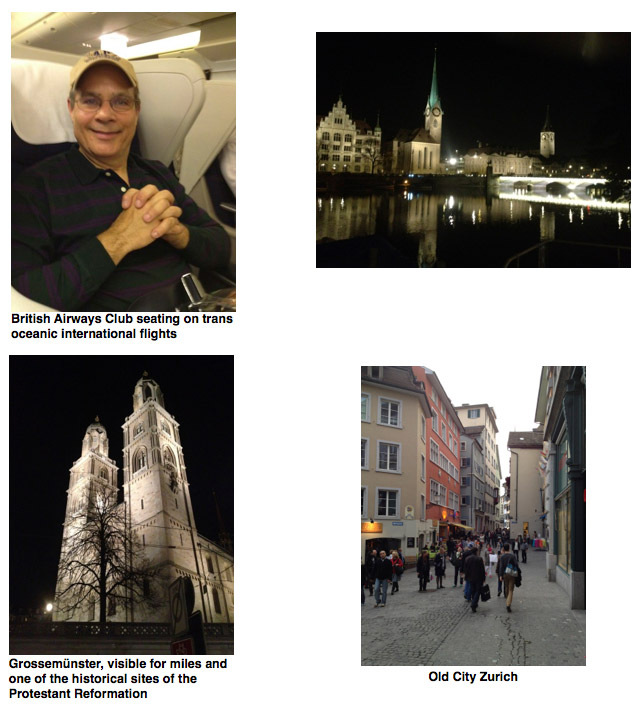
|
|
|
Departing from Philadelphia on Friday, 16 March, onboard British Airways (BA), we were pampered to no end by the crew and ground support personnel, making the almost seven-hour flight quite enjoyable. The BA Club Lounge in Philadelphia offered ample and comfortable seating and a complimentary full buffet dinner and drinks in addition to the excellent culinary faire onboard.
The new BA jets offer pods on international flights, fully reclinable high-back seats that become almost twin-bed size accommodations. These are equipped with private televisions, computer storage and electrical connections. I did have to become used to the British term for Mimosa (Buck’s Fizz), of which we had plenty. Salmon and champagne preceded a formal dinner of filet mignon with all the trimmings, then we reclined the ample seats and slept until breakfast.
Landing in Heathrow was more eventful. European security is different than US security, and we had to go through security one more time, even with a Fast Track designation that got us through preferred lines. Once again in the ample Club Lounge at the space ship-like British Airways Terminal Five to rest a bit, and we were ushered on the two-hour flight to Zurich, where we were fed once again.
The Flughafen in Zurich is marvelous. From the gate, with easy customs formalities, and using luggage carts that are escalator compatible, we went down three levels to the Bahnhof (train station) and were in downtown in twelve minutes onboard a high-speed train. From there, the tram took us to within a hundred feet of our hotel, a boutique hostelry smack in the middle of the medieval part of Zurich.
Arrival in the center of Switzerland’s largest city was uneventful and we spent a day and a half de-jet lagging and touring this magnificent city. Although this is my third time in Zurich, every time I’m here I am amazed. Zurich is a well-kept secret in Europe when it comes down to plain sophistication and understated elegance. Milano and Torino, not far away across the Italian border, can have the ubiquitous display of Prada, Versace, Benetton, Masseratis and Lamborghini. Zurich isn’t ostentatious, but it has it all. It is sophisticated and yet, low-key. Its citizens enjoy the highest quality of urban living in the world according to the United Nations qualifiers and it is Europe’s wealthiest town.
Zurich is also the financial capital of Switzerland, one of the most important banking centers in the world, and Switzerland’s jewelry and clock center. Our hotel was neatly nestled between 600-800 year-old buildings. I love history and spent an entire day visiting the sights. The old walled city of Zurich is now one of the most trendy areas in town, with high-fashion stores and upscale restaurants occupying ancient buildings dotted by al fresco restaurants.
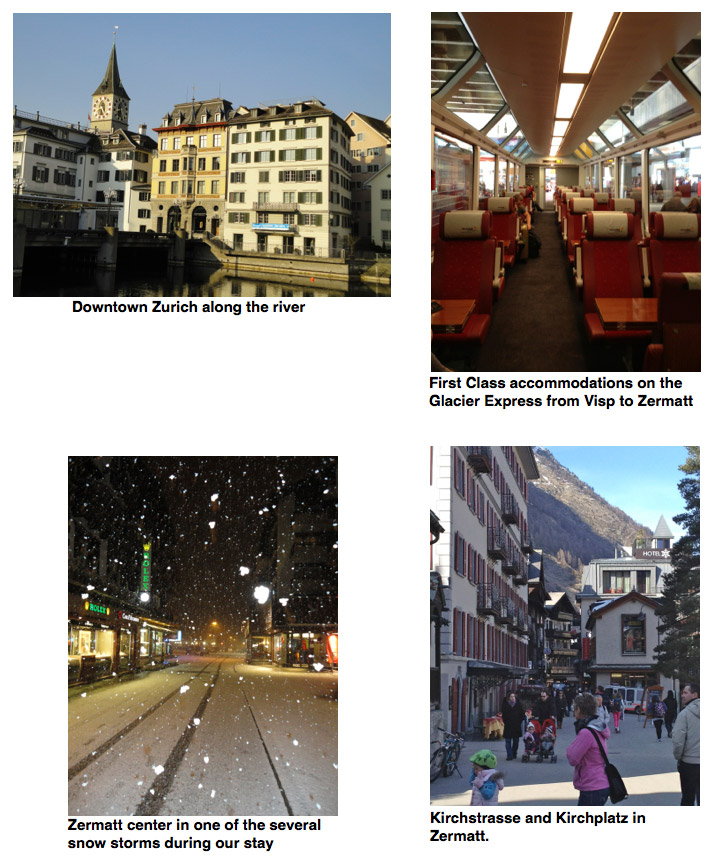
|
|
|
Taking a tour of Zurich is awe-inspiring. The city was settled almost 7,000 years ago. However, most of the Old City dates from 200 AD to the 1,200s and is now German-speaking. Its placement, at the Northern end of Lake Zurich, gives it a spectacularly beautiful location. With Roman ruins dating to 200AD, the city grew along the river and was also one of the original centers of the Protestant Reformation. We visited the Grossemünster, the old Abbey where Ulrich Zwingli, along with John Calvin in nearby Geneva, and Martin Luther in Wittenberg, Germany, began the Protestant Reformation.
The Grossemünster is an unforgettable sight. Built by Charlemagne nearly a thousand years ago, it is now a cultural center and houses the Museum of the Reformation. Its interior is monumental yet almost totally bare as a result of the iconoclastic nature of the Protestant Reformation that caused the Abbey to be stripped clean. The rest of the old city of Zurich is as wonderful, yet again, with understated elegance. The city has no subways, but it hosts a world-class tram system that is the envy of any urban area and it has traffic signal priority over motorized traffic. You can go virtually anywhere on public transport.
In addition, the streets are narrow but the sidewalks are huge, allowing their well dressed, sophisticated residents to enjoy the outdoors and al fresco seating in sidewalk cafes and restaurants. Even CEOs and international banking executives travel by bicycles or mass transit. Stop lights are designed to ensure that trolleys and bicycles have the right of way over motorized traffic.
The next day, we bid farewell to Zurich and took the short tram ride to the Bahnhof (train station) where we boarded the Swiss Rail through Bern to the city of Visp. As in most of Europe, their train system is amazingly modern, clean and timely, but in Switzerland, it is an integral part of their lifestyle. With the recent addition of several tunnels, one of them a whopping 20 miles long leading to Visp, their high-speed train system takes you from Zurich to the Swiss Alps in less than three hours.
The Swiss Rail system is undoubtedly the most punctual in the world. First Class seating is only three seats across, with a restaurant car dividing the first class from coach. It travels much faster than cars, being the choice of much of the population for comfort and speed. Once at Visp, we boarded the Matterhorn Rail that is able to use a cog system to catapult us 5,000 feet to the town of Zermatt, at the end of the line. Once there, we relaxed for an extra day before undertaking some serious skiing.
Before going further, there are a few things to explain about traveling in Europe and skiing in the Old Continent, particularly Switzerland, and most especially Zermatt. First, Europeans love their dogs, especially Germans, Austrians, and Swiss. There are dogs in restaurants. There are dogs in buses. There are dogs in trains, trams and subways. There are dogs in taxis. In virtually all hotels. In the gondolas. Atop ski areas. There are dogs in parks, museums, in short, virtually everywhere. Our furry family members don’t go free but instead pay the child’s fare everywhere they go, though. In Zermatt, dogs are also used in Alpine rescue in the same way they were used centuries ago. The overwhelming breed types were the native Bernese Mountain Dog, the Labrador Retriever, and the St. Bernard. I felt nostalgic for my Lab staying in a pup hotel.
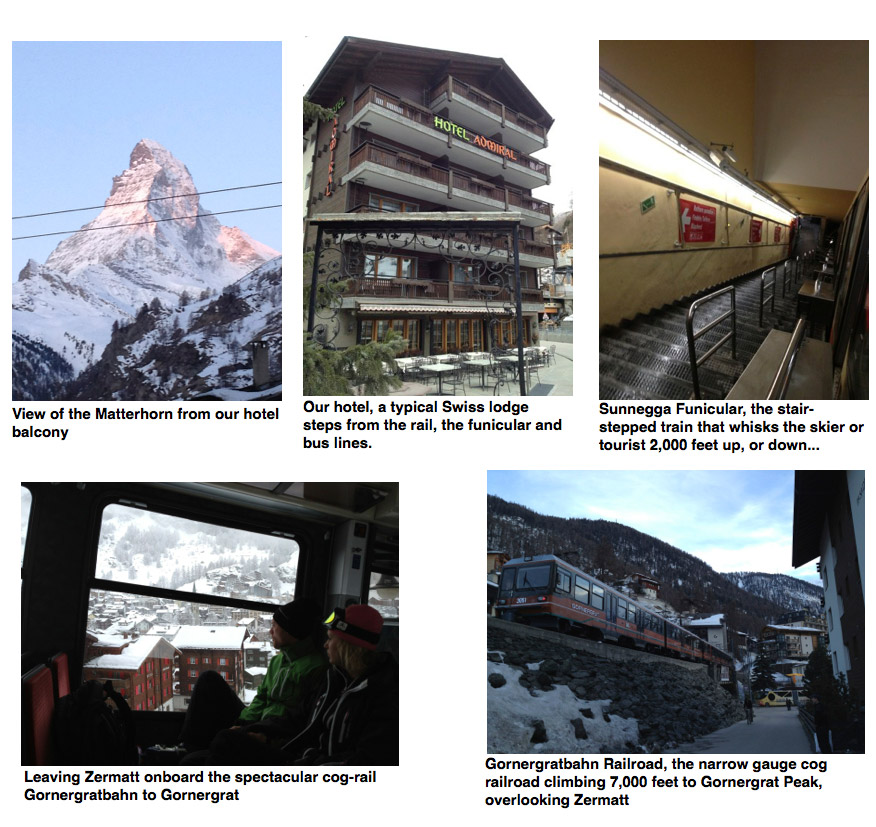
|
|
|
Swiss people: Despite its small size, Switzerland is a Confederation made up of Cantons, which enjoy even more sovereignty than our states in the US. Local affairs are solely the purview of each Canton, and these Canton prerogatives are vigorously defended. Zermatt is in the Canton of Valais, also called Wallis and during Napoleon’s time, Simplon, with a long and distinguished history. There are four languages spoken in Switzerland: German, French, Italian and Romansch. And most Swiss are fluent in all their native tongues, in addition to English, which is mandatory in all schools, especially in a country where international finance, diplomatic service and international trade play such a key role. Watching a conversation among a gathering of Swiss is like reading about the tower of Babel, except that each person understands each other’s language and yet speaks their mother tongue. With the old adagio of “When in Rome,” I made use of my passable French and Italian (and limited German) anywhere I was in contact with native Swiss people, and besides excellent treatment, it garnered additional respect as well as interesting conversation.
Prices: Ouch… With perhaps the strongest economy in Europe, the Swiss Franc is more expensive than the dollar, with an exchange rate close to US $1.10 for each Swiss Franc. Switzerland also suffers from a shortage of available labor due to the strong economy. For example, the unemployment area in Zürich is barely 2% and in Zermatt, it is just above 1%. In addition, hospitality workers are paid a full wage by law, that even though by-and-large eliminates tipping, it makes for very expensive vittles. Although our hotel included a sumptuous breakfast, lunch at an everyday place netted about US $30.00 per person, and dinners with wine at a select establishment could end up in atmospheric prices of around US $70-80 per person. Even in the only fast food outlet that somehow managed to get grandfathered in town many years ago, McDonalds, a Big Mac fetches about US $15.00. But well, we were on vacation…
Zermatt and Transport: At well over 5,000 feet altitude, Zermatt is at the headwaters of the Rhone Valley and it lines both sides of a narrow ravine along the Matter Vispa River, with the town extending a thousand feet above the city and with additional hamlets extending several thousand feet high, protected by a massive array of avalanche fences. The air is incredibly pure, chiefly the result of the town fathers outlawing the internal combustion engine in 1947. There are no cars, trucks, diesel buses or generators allowed.
The Zermatt area’s substantial electrical needs are provided by large hydroelectric plants nearby. Drivers from every part of Europe can drive their automobiles to the nearby town of Täsch about 7 miles away, then take the trains into town that run every twenty minutes.
Since my last visit to Zermatt eight years ago, however, there has been a huge expansion on the number of electric powered taxis. Without offending my father’s heritage, these electric taxis are driven by Italian taxi drivers with much of the reckless abandon as in Milano.
Zermatt has no sidewalks and the streets are narrow, about as wide as a single-lane street in the US (and these are the main drags). The alleys are literally several feet wide and flanked by hundreds of years old typical Swiss homes with their ancient dark wood set on piles of rough flagstones as protection against rodents, and featuring rough flagstone roofs. However, the main streets feature modern luxurious buildings, first-rate hotels, and distinguished restaurants. There are two bus lines that run along the two parallel main streets, the Green and Red Lines, all originating from the Bahnhof Platz and continuing in different directions. From our hotel, we could walk a hundred feet to the Sunnegga funicular, walk two blocks to the Gornergrat Rail, or wait for the Green Line electric bus (complimentary access with a lift ticket) and a direct shot to the Trockener Steg gondola. However, people walk everywhere, even on their snow boots. Zermatt has a permanent population of about 6,000 people and an almost year-round population of about 30,000 to 35,000 tourists. Besides the world-class skiing - one of the few places on the planet where there is round-the-year skiing and boarding, it is one of the most visited locations in Switzerland during the Spring through Fall, being extremely popular with hikers and mountain cyclists.
The Winter of 2011-2012 has been a boon for Europe’s ski industry. As so many US resorts experienced a serious shortfall of snow, European resorts had their best Winter in decades. Amsterdam residents were able to ice skate in their famous canals. The Alps received amazing snowfalls, and Zermatt was no exception. From talking to old timers, this was one of their best Winters on record. Massive snowfalls were followed by wonderfully sunny days, followed by more snow and even nicer days. This was a banner year for tourism in the Swiss Alps, and not only Europeans, but a record number of North Americans and Asian skiers came over to enjoy the outstanding conditions. The continuous snow created its share of problems, however. As a matter of fact, two gigantic avalanches outside of town cut off the resort city from the rest of the world for days.
After resting for most of Sunday, getting our rental skis ready next door to the hotel, securing our magnetic ski passes, good in both Swiss and Italian sides of the Matterhorn, and gathering an initial batch of souvenirs downtown, we started Monday with a ride on the Gornergrat cog rail. An easy walk to Zermatt’s transport center and we were on the Gornergrat station. The trains depart every fourteen minutes on the thirty-minute ride that climbs five thousand feet to some of the most gorgeous scenery on the planet. The rail makes several stops at quaint Swiss hamlets and hotel destination complexes such as Findelbach, Landtunnel, Riffelalp and Riffelberg, before arriving at Gornergrat Peak above 10,000 feet altitude. There are also express trains direct to Gornergrat that save about ten minutes.
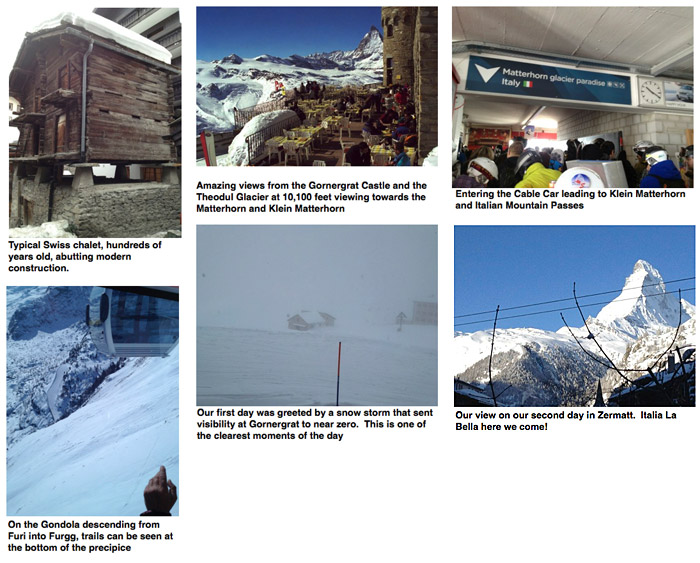
|
|
|
Once at Gornergrat Peak, the view is awe-inspiring. Twenty nine peaks towering over 13,000 feet surround Gornergrat, including Switzerland’s tallest peak, Mt Rosa, at 15,200 feet. The views of the Gorner and Theodul Glaciers are magnificent. Unfortunately for us, on the first day we had a freak snow storm that sent visibility plummeting down to a few feet. Above 10,000 feet, the snow depth was in the tens of feet and snow fell copiously. I had the wrong goggles, having brought bright-light lenses with me, and the flat light and lack of depth perception were troublesome. Totally white bottom, totally white in front, totally white above… I skied into a snowbank and only noticed it when I heard the “poof” of the snow.
Despite the adverse weather, we made the best of it. Taking advantage of a break in the visibility conditions, we skied down almost 4,000 feet to Riffelalp and took the train back to Gornergrat. Although meticulously groomed, the snow accumulated on the wide trails to make “freshies” a constant occurrence. From there, we took a different trail to Riffelalp and a six-pack high-speed lift with a welcome bubble cover to Gifthittli peak, just under Gornergrat. We stayed on these slopes close to an hour in constantly changing weather before venturing further on the Gornergrat area.
It is worth noting that in many parts of Europe, trail markings are different from those in the US. Instead of green, blue and black, blue is beginner, red intermediate, and black is expert. In addition, you can use yellow areas on unprepared surfaces at your own risk. As the trails are mostly above tree line, wide and often very steep, it can be easy to leave the trail and enter dangerous terrain. The sides of the trail are marked with yellow tape and the color of the trail difficulty to ensure the skier or boarder remains within the demarcated limits. There were many areas on the mountain that were off-limits, given the fact that the ski territory is on live glaciers and crevasses and precipices are the rule rather than the exception. In both Switzerland and Italy, many ski patrol members have police powers and can cite, fine and apprehend violators.
From the Riffelberg runs, we cut across the mountain to Gant area, about five miles away, before boarding a gondola to Blauherd Peak at 8,500 feet altitude. The Blauherd gondola crosses a ravine easily two thousand feet under its path, presenting amazing views. From Blauherd, we took a trail that started way above tree line, then proceeded down between the trees on a spectacularly beautiful run to Patrullarve, far away from Gornergrat but served by the Sunnegga Funicular. Once again on yet another six-pack (with a comfortable bubble) and an easy run to Sunnegga. With legs tired after a first-day ski adventure and senses shattered from low visibility, we boarded the funicular that leads from the mountaintop, inside the mountain, down to almost our hotel door. After a couple of hours in the hotel spa and partaking of Happy Hour, we were off to seek nourishment.
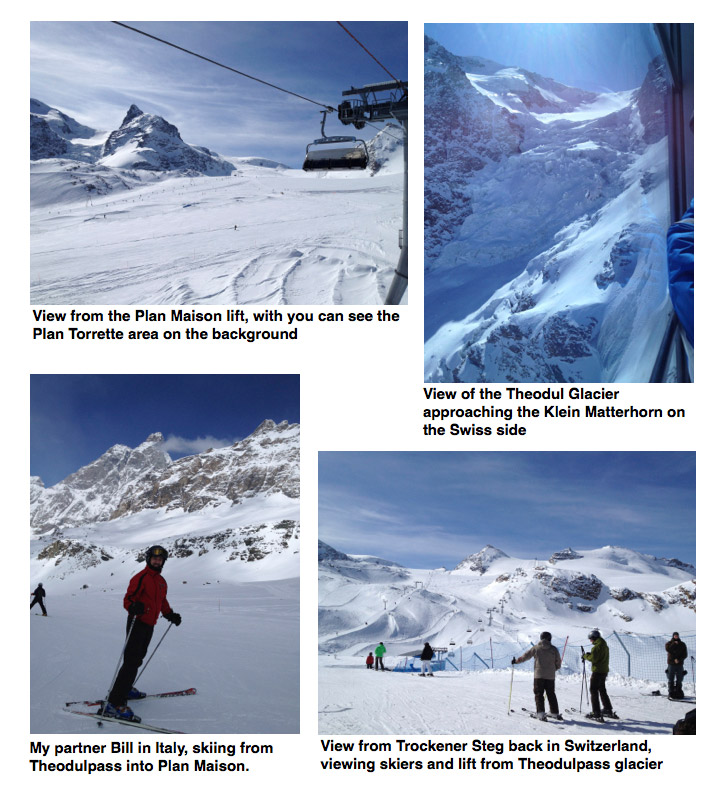
|
|
|
Our first night’s dinner was at Pizzeria Roma, about five easy walking blocks from our hotel. Excellent service, superb pizza and very good Valais local wines. Despite lacking reservations, the owner rapidly became our friend when I spoke Italian to him, and we had a great meal and sumptuous service, asking us to return anytime, which we did two days later. On our second visit, he offered us drinks and Limoncello on the house.
Our second full day in Zermatt turned out to be spectacularly sunny, barely below freezing in town, but about 10 degrees at altitude. We checked the weather at glacier altitude and both weather and wind conditions were optimal for a ski crossing into Italy. Our stomachs started churning with pleasure in anticipation. After a wonderful breakfast at the hotel, we took the Green Line bus to the Trockener Steg Gondola base. This six-person, multi-stop gondola starts in Zermatt’s western side, then climbs a thousand feet to Furi, then a two-thousand foot climb to Schwarzsee Peak, after which it turns left towards the Theodul Glacier, descends six hundred feet into Furgg, then makes a two thousand foot climb to Trockener Steg. The trip takes about twenty five minutes. From Trockener Steg, you can begin your ski day at altitude or board a cable car to the Klein Matterhorn, at almost 13,000 feet. The cable car ride is an additional fifteen minutes counting the wait time, for a total travel time of almost forty minutes from Zermatt to the Klein Matterhorn.
Once on top of the Klein Matterhorn, the gargantuan size of the Zermatt area becomes evident. A non-stop ski run from the Klein Matterhorn back to the base in Zermatt is easily 8,000 vertical feet and covers a distance of close to 13 miles. From Klein Matterhorn, one can ski on trails cut on the Theodul Glacier, returning to near Klein Matterhorn through a series of tow bars dug into the glacier ice, or head to Plateau Rosa (Testa Grigia in Italy) for the first of passes into Italy at close to 12,000 feet altitude. This first pass into Italy leads towards the Valtournenche ski area and town. A projected cable car between Plateau Rosa and Klein Matterhorn will be in operation in late 2012. Another set of trails leading from Klein Matterhorn and joining with more trails descending from Plateau Rosa lead to Theodulpass, the second mountain pass into Italy, this second pass leading to the Italian resort of Cervinia. Since I was there last, the number of transport facilities between the Swiss and Italian sides has increased, and several brand new, shiny cable cars whisk the snow lovers onto the mountain passes.
The other plus of the Italian side is that it faces the South, and even though it gets as much and perhaps more snow than the Swiss side, it is sunnier and brighter. In addition, the Italian side has what makes Italy such a great country, delicious food, incredible wines, and of course, Italian Espresso. At every thousand feet vertical, there was a slopeside restaurant, or a bar, or a rest stop. On the Italian side, given its bright sun, skiers and boarders could sip on wine while spread out on reclining chairs getting the sun. European skiers are much more relaxed than Americans, and seem to take their time and enjoy both the scene, the wine and the awesome food on the slopes.
We skied from Theodulpass on the border down to Plan Maison at 7,500 feet, and then towards Plan Torrette, a short distance and several hundred feet lower, to catch a high-speed six-pack lift to Cervino, as close to the headwall of the Matterhorn as possible. The skiing conditions on the Italian side were some of the best I’ve ever seen in my life, even with this being my third time in Zermatt. In addition to the incredible snowfalls this year, both the Swiss and the Italian sides have undertaken massive improvements in grooming and snowmaking… yes, snowmaking. The snow guns are designed to cover windblown areas to ensure skier comfort, in addition to a backup for future years of slim snowfall.
Being well above tree line, and besides the excellent grooming, the Italian side lends itself to very safe glade skiing on the glaciers, and off-piste skiing was simply incredible. Halfway into the afternoon, and there were still enormous areas that had not seen a skier. “Freshies” were available until we left. On many of these areas, the groomers would prepare a surface several hundred feet wide as a trail, while the rest was left to nature to fill with copious snow. The Italian side is much more benign than the Swiss side and despite the steepness of the terrain, the forgiving nature of the snow made it enjoyable and safe to push the comfort envelope.
We exhausted ourselves on these wonderful slopes before deciding to return to Plan Maison to begin the trek back to Switzerland. The return took a series of three high-speed four-packs. Many of these lifts, though high speed, are not detachable but the “magic carpet” variety. One literally walks into a fast-moving magic carpet before being whisked by the fast chairlift.
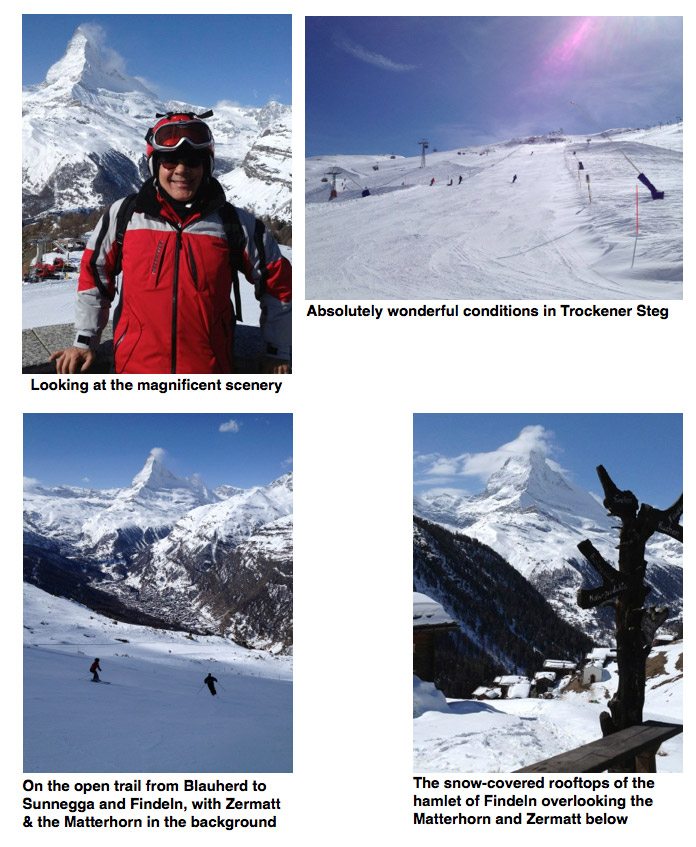
|
|
|
We arrived in Zermatt absolutely exhausted. After some number crunching, we realized that we had skied well in excess of 50 miles and about 30,000 vertical feet. Not too shabby for a ski day. After an hour in the hotel spa, partaking of Happy Hour with several French guests, and practicing the language of Balzac, we were off to a wonderful Swiss restaurant to savor Raclette and wine.
Our third day saw us returning to the Sunnegga area on the funicular. Getting onboard the funicular is a bit cumbersome but once inside, it is a short ride to the top. Skiers pass through the magnetic detector and walk in a tunnel inside the mountain for about 300 feet before climbing stairs that are aligned with the stair-like arrangement of the train. There is no change in the gradient of the cars throughout the journey; it climbs on the gradient for nearly 2,000 feet and once on top, you leave and go up stairs to the exit.
From Sunnegga, we exited the funicular and entered a strange combination of alternating six-pack chair/six person gondola to the top of Blauherd, at 8,400 feet altitude. This combination allows skiers from Blauherd to get back on the lift without shedding their equipment, while at the same time allowing the in-transit crowd from the base in Zermatt to transition from the funicular to the gondola without having to don skis/boards. On to of Blauherd, we then transitioned to a large 30-plus person cable car to the top of Rothorn, at 10,200 feet. With all those changes, the 5,000 feet climb from Zermatt to Rothorn is a 25-minute trip. With the rarified air, having ingested numerous glasses of wine the previous night to accompany the Raclette, and combined with the dry, high mountain air, we were definitely in need of hydration. It is important to note that proper hydration is a definite requirement at these altitudes to prevent altitude sickness.
At Rothorn, a series of wonderfully groomed runs kept us in that area for an hour. From Rothorn, trails of varied proficiency descend about 1,200 feet along a wide ravine to Kume, where a high speed quad returns skiers to Rothorn. This area allows off-piste skiing to satiate the adrenalin rushees. After six or seven runs, we descended 3,300 feet to Patrullarve through the same spectacular trail through the trees that we used on the first day. On our first day this run had been our escape during very inclement conditions. This time, with clear and sunny weather, the scenery was even more awe-inspiring and the run was breathtaking. One more climb on the Patrullarve six-pack to Blauherd, then down to Sunnegga and a short ski run to Findeln. Our hotel hosts had arranged for very difficult-to-get lunch reservations at one of Europe’s best Alpine restaurants, Chez Vrony.
The hamlet of Findeln is hundreds of years old and is still a living hamlet, although in recent times several local families have converted their chalets into restaurants, a few of which have garnered international followings and superb reputations for their quality and exclusivity of their offerings. Two of notoriety are Paradise and Chez Vrony. Reservations are a must. In both Swiss and Italian sides, diners come in for an entire afternoon. As I said previously, European skiers tend to be more relaxed than their American counterparts, and a lunch reservation on the mountain can extend into hours, even more on sunny days as this includes sunning by the terrace on sheep skin-covered lounge chairs while savoring wine and food. Chez Vrony has been in the Julen family for several hundred years, and serves only organic, locally grown produce and organic meats and fish from their own mountain stock. Our faire for lunch at Chez Vrony was fabulous. We savored a stupendous bottle of local Planscher Valais white wine, a rare grape variety that only grows in the high, dry Alpine regions of Switzerland and the Rhone Valley of France, along with a plate of local Valais Goat Cheese Croustade and a salad. Our main course featured a delicate mountain trout dish and finally, a 1/2 lb. local organic hamburger, probably one of the most delicately cooked meats I’ve ever had. Dessert included an assortment of Valais berries doused in Grand Marnier. We were seated on one of the best tables outside, on a deliciously warm day complimented by a hot sun and within feet of the precipice overlooking Zermatt two thousand feet below us. This was a remarkable lunch and a memorable event.
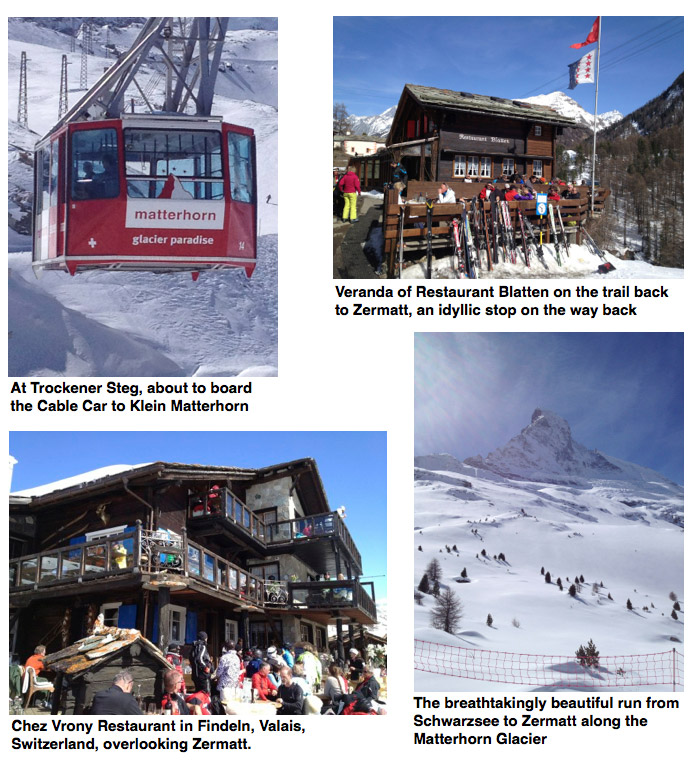
|
|
|
After an unforgettable lunch, we wanted to return to Sunnegga. For a relatively small community like Findeln, there are several criss-crossing trails leading in all directions, as residents ski or hike as their primary mode of transportation. From the base of Findeln, there are two lifts leading in opposite directions. We wanted the one to Sunnegga but instead, we took the wrong lift and ended up in Breitboden, about a thousand feet above Sunnegga. As it was getting late, we skied into Gant and took the gondola into Blauherd, from which we took an easy run back to Sunnegga and back on the funicular to Zermatt, ending less than a hundred feet from our hotel. The rest of the afternoon and evening was a shopping day and evening, relaxing at the hotel spa and enjoying the diverse crowd of skiers at Happy Hour. We walked around the Kirchplatz area, admiring the striking views of the mountains from the city as well as the splendid architecture of several of the classical grand hotels in the downtown area.
Our fourth day followed a snowy evening that deposited several feet of snow on the higher elevations, although just an inch or so in town. Still, early in the morning the Matterhorn peeked cloudlessly into our hotel room, auguring for a wonderful day. The sound of avalanche cannons echoed through town and quite a few runs were shown as being prepared, so we extended our breakfast and took the Green Line electric bus to the Trockener Steg gondola in the middle of a burning sun. Even though the temperature barely went above freezing, the bright Spring sun on a spotless day resulted in our shedding most of our mid-layers of clothing and opening the vents in our helmets and ski jackets.
With these awesome conditions, we decided to remain in the vicinity of the Trockener Steg - Theodulpass - Schwarzsee area enjoying the immaculately groomed runs and the wonderful weather. We stayed there until early afternoon, when our stomachs started grumbling with hunger, then descended into Schwarzsee to take my favorite scenic run in Zermatt and partake lunch on a wonderful Swiss restaurant. This 10-mile plus ski trail leads away from Schwarzsee literally under the immediate area of the Matterhorn and makes a gigantic curve on the Matterhorn glacier, crossing the glacier itself as well as several avalanche paths, losing sight of the entire world until the hamlet of Stafel, then turning back towards Zermatt, entering the tree line, and passing through the villages of Zmutt and Furi, before continuing along the path of the Schwarzsee gondola through the hamlets of Zum Zee and Blatten all the way back to Zermatt. Although marked as an intermediate run, it nonetheless is an absolutely splendid cruiser, traveling through astoundingly beautiful terrain and quaint villages where time has almost stopped on its tracks. On my first time in Switzerland, one of our travel group had taken us through this trail and it stayed indelibly etched in my mind. I was glad to be able to recreate the experience and share it again.
Although we had forgot to make reservations, we nonetheless decided to stop for a late lunch in Restaurant Blatten, which is literally on the ski trail back into Furi and Zermatt. Despite being full, the owner greeted us and was able to accommodate us in choice seats on the outside veranda, where we enjoyed local Valais Cheese Raclette, Wiener Schnitzel, and a bottle of Valais wine. After this wonderful lunch, we continued on the trail that leads directly into Zermatt, steps from the entrance to the gondola we had taken six hours before.
The evening festivities included - again, the spa, Happy Hour with the hotel guests, and a second visit to Roma Restaurant, where we were welcomed by name by the owner and enjoyed Italian-Swiss cheeses and a succulent gourmet pizza dinner cooked on their wood-fired stove in front of our eyes. Then we checked the weather once again and planned on another Italian visit for our last ski day in Zermatt.
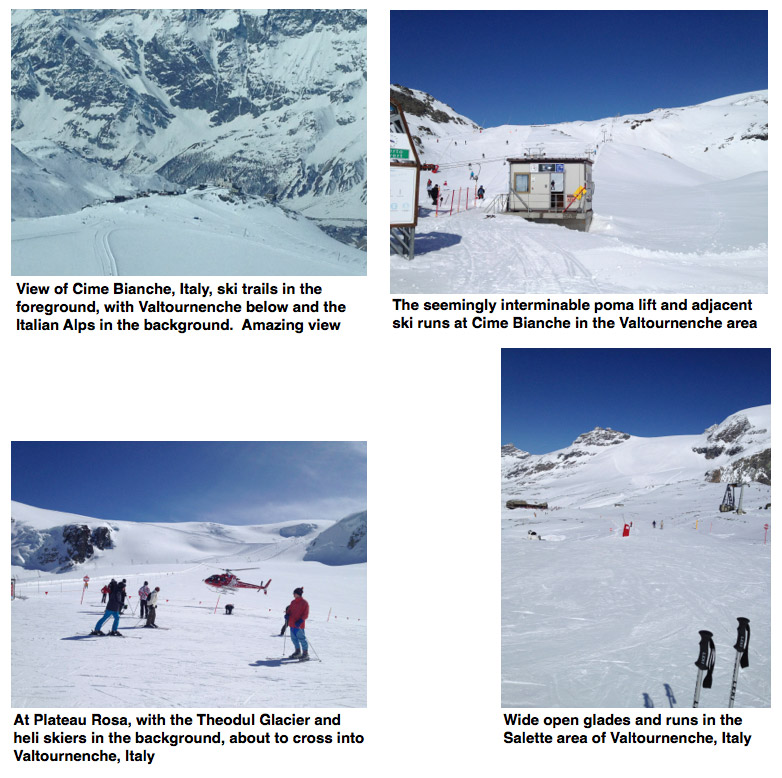
|
|
|
Our fifth and last ski day in Zermatt began with a bright sun shining through our windows. We knew it was going to be a wonderful day. Shining sun, temperature in town in the lower ’30s, and zero wind, a spectacular send off of a day for us.
After a great breakfast at the hotel, we once again boarded the gondola to Trockener Steg and the Matterhorn Cable Car, crossing the glacier into Plateau Rosa/Testa Grigia. This time, we planned to ski into Cime Bianche and Salette, an almost 6,000 foot vertical descent. The Valtournenche area has long, challenging and spectacularly beautiful trails, all above tree line. The downside of Valtournenche is that once we committed to skiing this area, it is miles away from the rest of the Cervinia/Matterhorn area with nearly no cross-trails to the other areas, meaning that we stayed there for most of the day. The Valtournenche area is a world in itself, with 6,500 vertical feet, a gondola, four lifts and a poma lift that runs as long as most long Eastern trails in the US. It is also an area of bright sun, plenty of snow, and superb terrain. And well appointed with a number of excellent eateries, all of them equipped with the seemingly mandatory reclining chairs pointed to the Southern sun. Between Salette in the bottom and Cime Bianche on top, 2,000 feet above the town of Valtournenche, both blue (beginner) and red (intermediate) trails cover 2,000 of vertical terrain, with off-piste fun for the experts.
As usual, we had an absolutely awesome lunch at Salette, being befriended by a huge group of German skiers from Munich while savoring an outstanding plate of pasta with Frutti Di Mare, unbelievably tasty bread and olive oil, and copious amounts of espresso. We relaxed for a bit in Salette, enjoying the company and the conversation of fellow skiers while at the same time, realizing that we had forgot our sunscreen and we were beginning to get sunburned. We donned our equipment again and skied the magnificent runs for another hour and a half, realizing that sometimes we were the only skiers on the slopes, before it became obvious that we needed to start our trek back to Plateau Rosa and Zermatt.
Departing Valtournenche is a bit cumbersome due to its separation from the rest of the Zermatt/Cervinia complex by a mountain range. Leaving Salette requires riding a four-pack high speed lift, followed by a six-pack high speed lift, then a poma lift to Colle Superiore Cime Bianche, then ski down a trail to Cime Bianchi’s Laghi lift, and then a brand new cable car to Plateau Rosa. The entire combination of lifts and trails took over 35 minutes. The brand new cable car from Laghi to Plateau Rosa allows spectacular views of the Italian Alps and, once on top, a breathtaking view of France, Italy and Switzerland, with Europe’s highest peak, Mt Blanc, visible in the background.
We spent about ten minutes on the veranda of the Cervino Cable Car admiring the Italian Alps and watching the clouds form over Mt Blanc. It was a stunningly beautiful day and the view was likewise, splendid. We skied the Plateau Rosa area for several runs, taking advantage of the rapidly dwindling number of skiers.
Most of the Plateau Rosa lifts are tow bars anchored into the glacier ice, and as a result, it is a bit tiring. There is, however, a new high-speed six-pack from Trockener Steg which makes the area much more accessible.
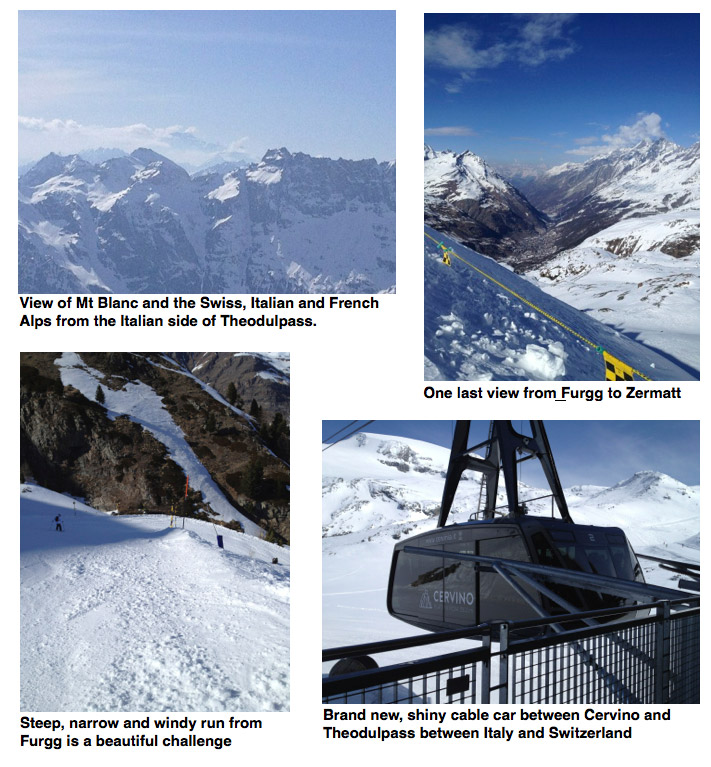
|
|
|
After an hour or so of skiing and taking a break for some hot chocolate, we began to consider returning to Zermatt to do a last bit of shopping, pack our bags, and enjoy the rest of the afternoon. Our day in Plateau Rosa and Valtournenche was magnificent, we probably had skied as much as our second day, when we tallied about 50 miles and 30,000 vertical feet. However, after a week of high-altitude skiing, good eating and meticulous hydration, I was full of energy and wanted to get a little challenge and as well, enjoy one last scenic view of the grand panorama which is Zermatt. We skied down from Plateau Rosa to Trockener Steg and then an intermediate run to Furgg, about 2,600 feet above Zermatt. My partner decided to take the gondola back home at this time, but I decided to ride one of the most beautiful expert trails in my life as a recreational skier.
This narrow run goes from the rear of Furgg down a ravine, sometimes at vertiginous descent rates, double fall lines and zig-zags, along a frozen waterfall, and entering tree line before joining the intermediate run into Zum Zee and Blatten, leading ultimately to Zermatt. Skiing this trail as the last trail in our vacation was an incredible experience, and the sights and sounds of this run will remain with me for many years until my return some day soon.
Descending into Zermatt, legs and body tired, thirsty and hungry, we took the Green Line electric bus back to the hotel, where we indulged once again in the hotel spa and the now traditional Happy Hour. After a nice walk in town, our final Zermatt dinner was at Restaurant Schaferstübli, one of the best in town, downstairs from the Julen Hotel. I enjoyed the best, most succulent Valais Lamb Entrecôte I’ve ever had, washed down with the best Valais wine. After dinner, we strolled the town to settle the wonderful dinner and prepare for our departure next morning.
Our departure on the Swiss Train System’s Glacier Express was flawless. It is notable to say that we had a Swiss Rail Pass, which allows unlimited travel on the entire Swiss transportation system including all trains, buses, subways, trams, and trolleys in the country. Swiss Rail Passes can be purchased for a certain number of travel days, which do not have to be consecutive. Our first class tickets were therefore valid everywhere. The tram system in urban areas is by-and-large, an honor system, and conductors don’t check everyone coming in and out. However, there are sporadic checks by transit police and penalties are onerous. Suffice it to say that in the countryside as well as the cities, we felt absolutely safe while in Switzerland, which enjoys one of the lowest crime rates in the world.
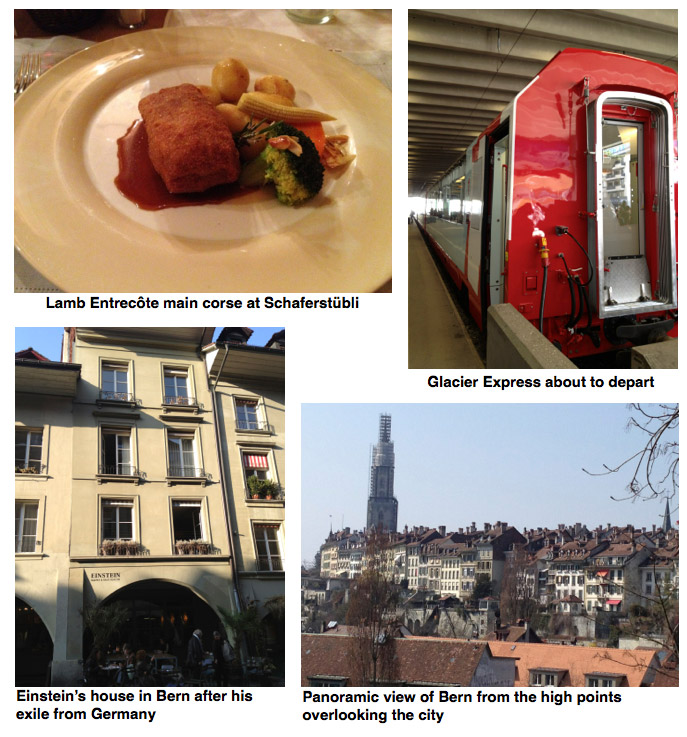
|
|
|
The train left on the second, no earlier, no later, in typical Swiss timeliness. This time the route was downhill, with the same spectacular, eye-popping views of the Swiss Alps, and a view of the recent gigantic avalanche that cut off the Zermatt area from the world for days. The ride was relatively short but it is indeed time consuming, given the railway must run on cogs because of the massive altitude difference. Arrival at Visp was also on the second, and we had a scant five very scheduled minutes to catch a train to Bern. On the Swiss Train system, it pays to know which gate you arrive and depart, since train connections are normally less than ten minutes. Again, we were treated to a high-speed train ride through a series of tunnels through the Alps on the way to Bern, including the 20-mile mega-tunnel that has made the ski areas less than a day trip from Switzerland’s major cities, and a weekend joist on the bullet trains from Paris or most places in Germany.
We arrived in Bern on time during a warm and beautiful day, where we saw our friend René and had a tour of this spectacular medieval town. Bern’s ancient downtown, dating from over a thousand years ago, has been designated as Patrimony of Humanity by the United Nations, and with good reason. Almost every building has been meticulously restored, automobile traffic is severely restricted, with parking inside the city prohibited except on weekends, and electric trams connect and criss-cross the entire city. We climbed on the cobblestone roads, now lined with embassy residences, to the heights that dominate the medieval city and the views from there were amazing. Our lunch was at a spectacularly beautiful contemporary venue, the Rosengarten Restaurant, overlooking Bern from a beautiful park 500 feet above the city. The menu was superb, with grilled organic pork and local vegetable melange, spiced with the restaurant’s own herbs from its own garden. We washed it down with a delightful local white wine.
We spent the rest of the afternoon touring this magnificent city, the Bundeshaus or the Federal Capitol, the buildings of the Swiss National Bank, and the magnificent 13th century Zytglogge tower. Bern was formerly walled in, and protected by its strategic location as a peninsula projecting into the Aare River. Despite its dense population, over 30% of the city is forested, a tribute to its citizens.
Late in the afternoon, we went back to the Bahnhoff and boarded the high-speed train to Zurich for a short trip back to Zurich, back in the Adler Hotel in the middle of the old city of Zurich. We once again walked the city, admiring the sights, and took dinner al fresco in the Odeon Cafe, perhaps one of the most historic cafes in Europe. The Odeon was the birthplace of the intellectual effervescence before World War I, and was the place of origin of Dadaism, being popular with Europe’s intellectual elite of all walks of life and persuasions. Some of its notable frequent visitors included Albert Einstein, Arturo Toscanini, James Joyce, and Vladimir Lenin, as well as many writers and musicians fleeing Nazi Germany. The Odeon is by the river, and affords a wonderful view of both people and the city.
The next morning, we woke up early to be able to take the tram to the rail station, then a short ride to the airport and a 10 AM British Airways flight to London, with a quick connection in Heathrow to Philadelphia, putting an end to a most wonderful vacation.
While actually born in the tropics (Cuba), Lou grew up in New England and went to College in Vermont, where he initially took up skiing. He then embarked on a twenty-two year Air Force piloting career that took him to over 50 countries. He has skied in Europe and America (both North and South). His second career as a senior officer with the Federal Government spanned thirteen years and in 2010, Lou retired to pursue a more leisurely life style.